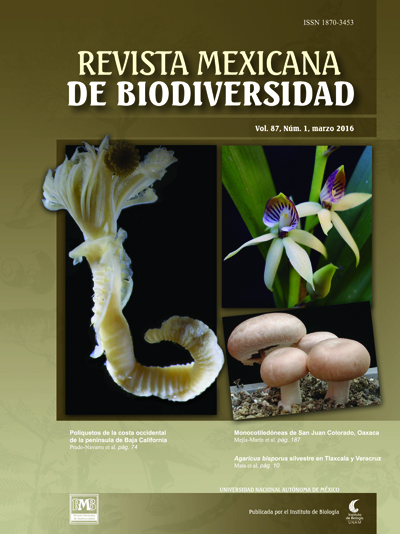ISSN-versión electrónica: 2007-8706
Factor de impacto 2024 (publicado junio, 2025): 0.9
FI de 5 años: 1
CiteScore (Scopus, 2024): 1.6
Revista Mexicana de Biodiversidad por IB-UNAM se distribuye bajo una Licencia Creative Commons Atribución-NoComercial-SinDerivar 4.0 Internacional
Revista Mexicana de Biodiversidad, Año 3, No. 12, enero-marzo 2014, es una publicación trimestral editada por la Universidad Nacional Autónoma de México, Ciudad Universitaria, Delegación Coyoacán, C.P. 04510, Ciudad de México, a través del Instituto de Biología, Tercer Circuito Universitario s/n, Ciudad Universitaria, Col. Copilco, Del. Coyoacán, C.P. 04510, Ciudad de México, Tel. (55)56229164, https://revista.ib.unam.mx/index.php/bio/
falvarez@ib.unam.mx Editor responsable: Dr. Fernando Álvarez Noguera. Reserva de Derechos al Uso Exclusivo No. 04-2013-092709142100-203, ISSN: 2007-8706, ambos otorgados por el Instituto Nacional del Derecho de Autor, Responsable de la última actualización de este número, Instituto de Biología, UNAM, Dr. Fernando Álvarez Noguera, Tercer Circuito Universitario s/n, Ciudad Universitaria, Col. Copilco, Del. Coyoacán, C.P. 04510, Ciudad de México, fecha de la última modificación: 25 de agosto de 2016.
Las opiniones expresadas por los autores, no necesariamente reflejan la postura del editor de la publicación. Se autoriza la reproducción total o parcial de los textos aquí publicados siempre y cuando se cite la fuente completa y la dirección electrónica de la publicación.
https://revista.ib.unam.mx/index.php/bio/
Sitio implementado por el equipo de la Subdirección de Revistas Académicas y Publicaciones Digitales de la Dirección General de Publicaciones y Fomento Editorial de la UNAM sobre la plataforma OJS3/PKP.




